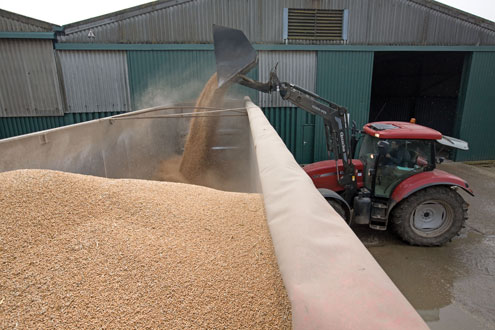Accurate grain sampling more critical than ever this season

We’ve all been there. You take a series of grain samples at home, get them tested, and market the crop accordingly. Three lorry loads go off without a problem, and then there’s a rejection or a claim for poor quality – how can that be right?
Unfortunately, this year has been worse than most, because the crop was enormously variable even within fields, let alone across the whole farm. Add in a few unreliable sampling or testing techniques and the whole problem is exacerbated.
If not conducted thoroughly, sampling has been found by HGCA to be the source of about half of the potential error in grain quality analysis. According to Guy Gagen, chief arable adviser at the NFU, there are three steps to accurate grain testing: how the sample is taken, how it is prepared and how it is actually tested. “There is a vast amount of information out there, but it can be difficult to plough through, so we’ve condensed it down into some simple guidance.”
On-farm sampling
Many growers take samples of grain as it comes into store, but they should also sample grain again during storage to monitor quality, and again at outtake to know what they are selling, says Dhan Bhandari, research and knowledge transfer manager at HGCA.
Growers should ideally take one sample per 5t from trailers or one per 10t from a drier, and then carefully mix them to make a representative sample – usually 1-3kg – for each 100t in store.
“Even when following best practice, I think there will be variation in samples this year, because there is so much variability in the crop,” says Mr Bhandari. “It would be sensible to take the middle ground with variable test results, rather than opting for the merchant that has the best quality results.”
Sampling at intake
Most grain contracts specify that intakes must follow the ISO standard for sampling, which requires them to take eight sub-samples from a 29t lorry to achieve a representative sample for analysis. Research has shown that taking just one sample from a 29t lorry only carries a 50% chance of being representative of an entire load. “In practical terms this means that when lorries are sampled with a single sample, in the event of a dispute, there is a 50/50 chance that resampling will give a different result.”
This year, low bushel weights have been particularly problematic, sparking some concerns over the use of vacuum spears. “There are very few true vacuum spears being used these days, but anyone using one needs to be particularly careful to take a representative sample,” says Mr Gagen.
“However, even with the most up-to-date technology, you still have to be careful how you sample and handle the grain or the reliability of test results will suffer. If the sampling is for claims or independent testing, samples should be drawn jointly by representatives of both the customer and supplier, unless agreed otherwise.”
Eamonn Neale, international sales manager at TekPro, highlights that the ISO 24333 international standard for cereal sampling requires that both the method and equipment are suitable for the task. “If the sampling method is not representative, you will not get an accurate analysis.”
Samplex automatic samplers allow grain to fall into an aperture by gravity, and then use air flow to take the grain away. “The systems are designed to take a representative core sample, but there can be considerable separation of fine screenings during transfer, so it is always important to mix samples thoroughly before testing,” says Mr Neale.
“Samples will then need to be divided using a sample divider. There is no logic in a company spending thousands of pounds on grain analysing equipment for its lab and then testing an unrepresentative sample.”
Laboratory analysis
Under the Trade Assurance Scheme for Combinable Crops (TASCC), laboratories are required to calibrate and test their equipment regularly to ensure its accuracy, says Paul Rooke at the AIC. “You need to make sure you’re using best practice in all instances, particularly if there’s going to be a claim involved – best practice doesn’t end at the spear.”
Processors assess basic quality parameters at grain intake. “To achieve efficient turnaround of lorries and control laboratory costs, results have to be available within minutes,” says Mr Gagen. “For routine analysis, rapid methods are preferred to more time-consuming primary tests.”
Most laboratories analyse bushel weights with automatic testers, typically using 250g samples. But following the release of new British Standards in 2009 and with the variable quality of this year’s crop, they should consider using larger cylinder measures to give a more accurate reading, he adds.
“I’m not confident that a 250g sample is accurate enough for the low bushel weights we have got this year. Although these automated machines are perfectly alright in a normal year, laboratories should be using cylinder measures of nearer one litre to give a more robust reading, critical below 68kg/hl. If you’re going to be making a quality claim, it’s only right to carry out thorough sampling and testing.”
Bushel weight battle intensifies

